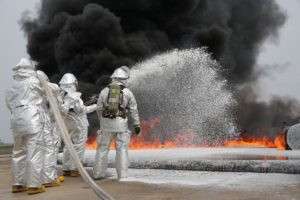Facing ‘substantial’ cleanup costs, Dane County looks to sue PFAS makers
Chris Hubbuch | Wisconsin State Journal Jan 21, 2022
Read online

Facing mounting pressure to clean up toxic waste at the Dane County Regional Airport, the county is planning to sue the makers of so-called “forever chemicals.”
County Executive Joe Parisi announced Thursday that he would introduce a resolution authorizing the county to hire outside attorneys to pursue class-action litigation against manufacturers of fluorinated compounds known as PFAS.
“PFAS manufacturers made millions selling these products and we owe it to the taxpayers of Dane County to make sure they aren’t forced to pay for cleaning up the contamination that resulted from using firefighting foam,” Parisi said in a statement announcing the resolution. “Too often big corporations make huge profits and then walk away when a problem is discovered, leaving taxpayers stuck with the clean-up bills.”
Parisi said the county faces “substantial costs” associated with investigating and cleaning up PFAS contamination linked to firefighting foam used for decades in emergency response and training around the airport.
Deputy Corporation Counsel Carlos Pabellon said the county has not selected an outside law firm but plans to hire one on a contingency basis, meaning there would be no upfront costs.
Parisi likened the multi-jurisdictional litigation process to actions the county has taken against opioid manufacturers.
The city of La Crosse, facing similar cleanup challenges at its airport, last year sued nearly two dozen chemical companies it says knew for decades that their products were hazardous to human health but failed to warn customers. The state has hired the Sher Edling law firm to go after manufacturers.
It has been almost four years since the Department of Natural Resources informed the county, along with the Wisconsin National Guard and the city of Madison, that they were responsible for PFAS contamination on and around the base.
The National Guard Bureau is conducting cleanup under the Comprehensive Environmental Response, Compensation and Liability Act, or CERCLA, a process under which actual cleanup may not begin for at least a decade.
Last year the DNR approved a plan to find where PFAS-contaminated groundwater is seeping into the stormwater system and seal up leaky pipes while the county continues testing an experimental technology that the DNR previously said had failed to keep PFAS out of lakes and streams.
The county notified the DNR last fall that storm sewer repairs had been delayed until sometime in 2022.
Used in firefighting foam, stain-resistant fabrics and thousands of other products, PFAS have been linked to illnesses including cancer and liver disease. The chemicals have contaminated a municipal well about a mile from the airport, as well as Starkweather Creek and Lake Monona, which are now under fish consumption advisories.
The EPA has said drinking water is safe with combined PFOS and PFOA concentrations up to 70 parts per trillion, though new agency documents suggest that level should be just 1 ppt. Groundwater samples from the airport have shown PFOS alone at concentrations reaching 48,000 ppt.
The DNR is finalizing rules that would set drinking and groundwater standards at 20 ppt, in line with the recommendations of state health officials. If approved by the Legislature, those standards would be in place by 2023.
